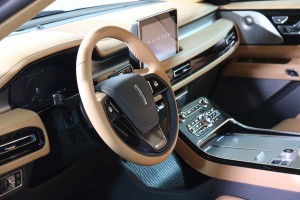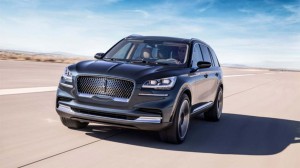When you’re struggling to gain some altitude it helps to have a good aviator on hand. Make that Aviator, the all-new version of what had been known as the Lincoln MKT. The new model, making its debut at the New York International Auto Show, is more than just a new name, however, getting an all but complete, ground-up makeover.
One of two new SUVs coming for the brand by 2020, the new Lincoln Aviator is part of an aggressive push aimed at rebuilding a once shining star in the American luxury firmament while also helping Lincoln gain ground in what has become its fastest-growing market, China.
That’s where the new Aviator could see the strongest demand for its optional plug-in hybrid drive system, especially considering the tough new zero-emissions mandates Chinese regulators put in place late last year.
“Electrification will play an important role in Lincoln’s future,” said Joy Folotico, the Ford Motor Co. veteran who assumed control of the brand earlier this month following the promotion of former Lincoln boss Kumar Galhotra.
(Lincoln launching Aviator in New York. Click Here for the story.)
As with a number of products being launched at this year’s New York International Auto Show, the Lincoln Aviator is officially being described as a “concept,” though executives confirmed that what we’re seeing in the Big Apple is quite close to what will roll into showrooms in 2019. There are the usual exaggerated features, such as the undersized mirrors and oversized wheels. But the ute’s basic stance and dimensions are what industry insiders like to describe as “production intent.”
Look for a final version measuring about 10 inches shorter than the standard-length Navigator, at 200 inches nose-to-tail, and 30 inches longer than the new Lincoln Nautilus.
It’s definitely not a cab-forward design. The Aviator concept sits tall and proud, with a long hood that speaks of power – though, for now, the Lincoln team isn’t ready to reveal many details about what’s under the hood beyond confirming there will be that PHEV and at least one gas offering. We’re anticipating a twin-turbo EcoBoost V-6 will be among the options.
What’s intriguing is that the engineering team says the PHEV is an all-new system that will add its electronic drive to the same twin-turbo six used for the standard model. That could actually translate into a high-performance, or at least higher-performance model, much as we’ve seen from Volvo with its plug-in T8 powertrain.
Up front, the concept adopts an almost reverse version of the new Lincoln signature grille found on models such as the big Continental sedan. The silhouette features three distinctive details, a fast-falling roofline, a rising rocker line and sculpted, almost organic fenders and door panels that play with the light in ways unseen on typically slab-sided SUVs.
“If you look at a bird or a plane in flight, the wing is always at an angle to the air and falling downward toward the rear,” said Lincoln design chief David Woodhouse. “From the headlight to the taillight, there’s a beautiful undercut feature varying in depth that connotes poise and grace.”
Inside, the Lincoln Aviator Concept picks up on some of the elegant detailing found in the Continental, with horizontal surfaces that expand the apparent width of the cabin.
There are three rows of seats providing room for six – or seven, with the optional, second-row bench. And that’s six or seven adults. The back row is not the usual penalty box assigned to children – or adults you really don’t like.
Lincoln officials promise that the production version will deliver the sort of on-road silence that rival Lexus has been known for – while all but floating overall potholes thanks to a camera-based system that can detect road conditions as much as 20 feet ahead of the vehicle and automatically prepare the electronically adjustable shocks before a vehicle hits a bump or falls into a pothole.
(Click Here for more about the product influx coming from Ford.)
Expect plenty of other high-tech comfort and safety features, including automatic emergency braking both front and rear.
Meanwhile, Folotico emphasized that Aviator buyers will find all the new “luxury experience” touches that Lincoln hopes will help it differentiate itself from other brands, including free pick-up and delivery – along with loaners – when a vehicle needs service or repairs.
“It’s going to be a game-changer,” said the new Lincoln boss.
It’s going to need to be. Once battling it out with domestic rival Cadillac for dominance in the American market, Lincoln is today an also-ran at home. But it has begun to show some life, especially in China where it made its debut only a couple years ago.
(To see more about Lincoln upping its star power with Serena Williams, Click Here.)
Ultimately, whatever the experiential elements Lincoln comes up with, however, product is still going to be critical to the brand’s revival.





A slight correction to the lead paragraph is in order.
“Make that Aviator, the all-new version of what had been known as the Lincoln MKT.”
Nautilus is “the all-new version of what had been known as the Lincoln MKX.”
Both of these new designs are visually appealing to me.
I do prefer the greater bling of the Aviator’s front grille, created by its elements of Lincoln logo ingots, over than the Lincoln logo cutouts used in the Nautilus & Continental grilles.
Thanks for the catch on an error made in he middle of the night!
Paul E.